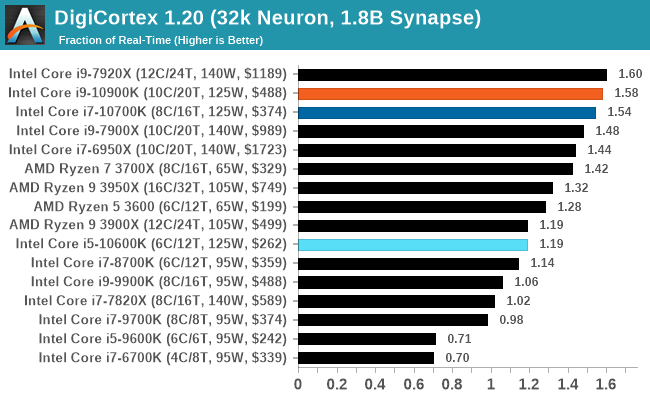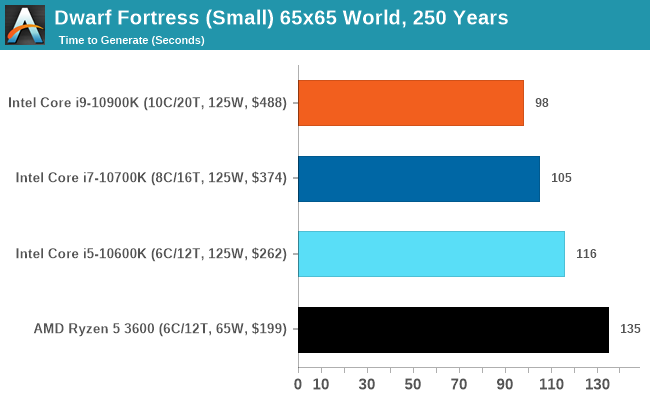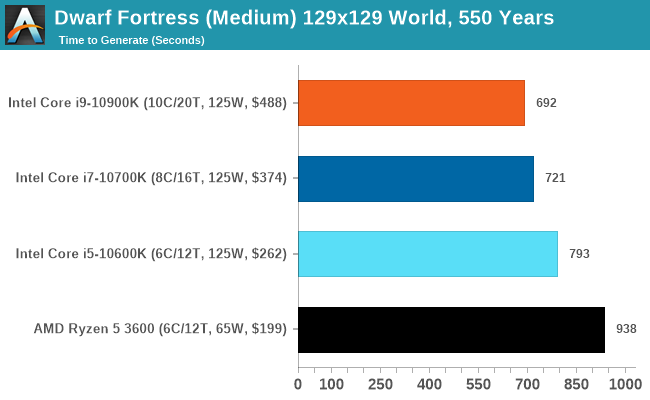The Intel Comet Lake Core i9-10900K, i7-10700K, i5-10600K CPU Review: Skylake We Go Again
by Dr. Ian Cutress on May 20, 2020 9:00 AM EST- Posted in
- CPUs
- Intel
- Skylake
- 14nm
- Z490
- 10th Gen Core
- Comet Lake
CPU Performance: Simulation Tests
A number of our benchmarks fall into the category of simulations, whereby we are either trying to emulate the real world or re-create systems with systems. In this set of tests, we have a variety including molecular modelling, non-x86 video game console emulation, a simulation of the equivalent of a slug brain with neurons and synapses firing, and finally a popular video game that simulates the growth of a fictional land including historical events and important characters within that world.
NAMD ApoA1
One frequent request over the years has been for some form of molecular dynamics simulation. Molecular dynamics forms the basis of a lot of computational biology and chemistry when modeling specific molecules, enabling researchers to find low energy configurations or potential active binding sites, especially when looking at larger proteins. We’re using the NAMD software here, or Nanoscale Molecular Dynamics, often cited for its parallel efficiency. Unfortunately the version we’re using is limited to 64 threads on Windows, but we can still use it to analyze our processors. We’re simulating the ApoA1 protein for 10 minutes, and reporting back the ‘nanoseconds per day’ that our processor can simulate. Molecular dynamics is so complex that yes, you can spend a day simply calculating a nanosecond of molecular movement.
This is one of our new tests, so we will be filling in more data as we start regression testing for older CPUs.

Dolphin 5.0: Console Emulation
One of the popular requested tests in our suite is to do with console emulation. Being able to pick up a game from an older system and run it as expected depends on the overhead of the emulator: it takes a significantly more powerful x86 system to be able to accurately emulate an older non-x86 console, especially if code for that console was made to abuse certain physical bugs in the hardware.
For our test, we use the popular Dolphin emulation software, and run a compute project through it to determine how close to a standard console system our processors can emulate. In this test, a Nintendo Wii would take around 1050 seconds.
The latest version of Dolphin can be downloaded from https://dolphin-emu.org/

DigiCortex 1.20: Sea Slug Brain Simulation
This benchmark was originally designed for simulation and visualization of neuron and synapse activity, as is commonly found in the brain. The software comes with a variety of benchmark modes, and we take the small benchmark which runs a 32k neuron / 1.8B synapse simulation, equivalent to a Sea Slug.
Example of a 2.1B neuron simulation
We report the results as the ability to simulate the data as a fraction of real-time, so anything above a ‘one’ is suitable for real-time work. Out of the two modes, a ‘non-firing’ mode which is DRAM heavy and a ‘firing’ mode which has CPU work, we choose the latter. Despite this, the benchmark is still affected by DRAM speed a fair amount.
DigiCortex can be downloaded from http://www.digicortex.net/

The additional bandwidth of the HEDT platforms put them higher up the chart here - Digicortex always ends up as an odd mix of bottlenecks mostly around memory, but it can be localized internal bandwidth limited as well.
Dwarf Fortress
Another long standing request for our benchmark suite has been Dwarf Fortress, a popular management/roguelike indie video game, first launched in 2006. Emulating the ASCII interfaces of old, this title is a rather complex beast, which can generate environments subject to millennia of rule, famous faces, peasants, and key historical figures and events. The further you get into the game, depending on the size of the world, the slower it becomes.
DFMark is a benchmark built by vorsgren on the Bay12Forums that gives two different modes built on DFHack: world generation and embark. These tests can be configured, but range anywhere from 3 minutes to several hours. I’ve barely scratched the surface here, but after analyzing the test, we ended up going for three different world generation sizes.
This is another of our new tests.














220 Comments
View All Comments
yankeeDDL - Wednesday, May 20, 2020 - link
I think the main idea was to show if the CPU was getting in the way when teh GPU is definitely not the bottleneck.mrvco - Wednesday, May 20, 2020 - link
That's difficult to discern without all the relevant data.. i.e. diminishing returns as the bottle-neck transitions from the CPU to the GPU at typical resolutions and quality settings. I think better of the typical AnandTech reader, but I would hate to think that someone reads this review and extrapolates 720p / medium quality FPS relative performance to 1440p or 2160p at high or ultra settings and blows their build budget on a $400+ CPU and associated components required to power and cool that CPU with little or no improvement in actual gaming performance.dullard - Wednesday, May 20, 2020 - link
Do we really need this same comment with every CPU review ever? Every single CPU review for years (Decades?) people make that exact same comment. That is why the reviews test several different resolutions already.Anandtech did 2 to 4 resolutions with each game. Isn't that enough? Can't you interpolate or extrapolate as needed to whatever specific resolution you use? Or did you miss that there are scroll over graphs of other resolutions in the review.
schujj07 - Wednesday, May 20, 2020 - link
“There are two types of people in this world: 1.) Those who can extrapolate from incomplete data.”diediealldie - Thursday, May 21, 2020 - link
LMAO you're geniusDrKlahn - Wednesday, May 20, 2020 - link
In some cases they do higher than 1080p and some they don't. I do wish they would include higher resolution in all tests and that the "gaming lead" statements came with the caveat that it's largely only going to be beneficial for those seeking low resolution with very high frame rates. Someone with a 1080p 60Hz monitor likely isn't going to benefit from the Intel platform, nor is someone with a high resolution monitor with eye candy enabled. But the conclusion doesn't really spell that out well for the less educated. And it's certainly not just Anandtech doing this. Seems to be the norm. But you see people parroting "Intel is better for gaming" when in their setup it may not bring any benefit while incurring more cost and being more difficult to cool due to the substantial power use.Spunjji - Tuesday, May 26, 2020 - link
It's almost like their access is partially contingent on following at least a few of the guidelines about how to position the product. :/mrvco - Wednesday, May 20, 2020 - link
Granted, 720p and 1080p resolutions are highly CPU dependent when using a modern GPU, but I'm not seeing 1440p at high or ultra quality results which is where things do transition to being more GPU dependent and a more realistic real-world scenario for anyone paying up for mid-range to high-end gaming PCs.Meteor2 - Wednesday, July 15, 2020 - link
Spend as much as you can on the GPU and pair with a $200 CPU. It’s actually pretty simple.yankeeDDL - Wednesday, May 20, 2020 - link
I have to say that this fared better than I expected.I would definitely not buy one, but kudos to Intel.
Can't imagine what it means to have a 250W CPU + 200W GPU in a PC next to you while you're playing. Must sound like an airplane.